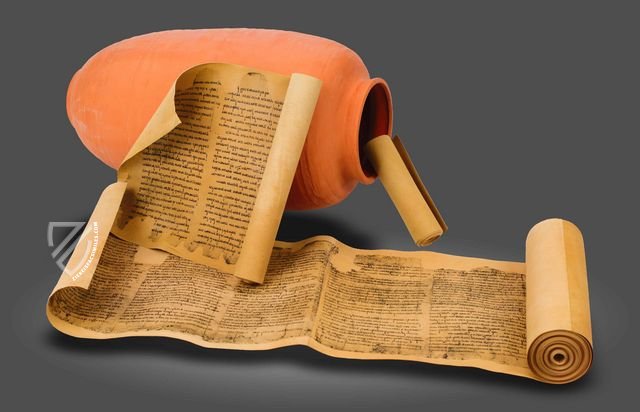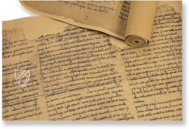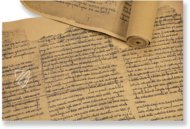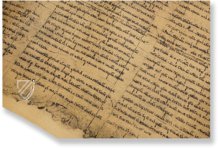Dead Sea Scrolls
(3,000€ - 7,000€)
The famous Dead Sea Scrolls belong among the most spectacular archeological finds of the 20th century. Some caves were discovered coincidentally by Bedouins near Qumran on the Dead Sea in 1947, in which mysterious scrolls of parchment were hidden in clay pots. These documents are 2,000 year old testimonies to ancient Judaism! The scrolls also have an extraordinary importance for the Christian Bible. The compendium assembled here presents three of the best-surviving scrolls, in addition to three additional fragments of documents from one of the caves. The scrolls from Qumran are unique pieces of world history!
Dead Sea Scrolls
The famous Dead Sea Scrolls belong among the most spectacular archeological finds of the 20th century. Some caves were discovered coincidentally by Bedouins near Qumran on the Dead Sea in 1947, in which mysterious scrolls of parchment were hidden in clay pots. These documents are 2,000 year old testimonies to ancient Judaism! The scrolls also have an extraordinary importance for the Christian Bible. The compendium assembled here presents three of the best-surviving scrolls, in addition to three additional fragments of documents from one of the caves. The scrolls from Qumran are unique pieces of world history!
A Religious Book and Religious Rules of Conduct
The compendium of three great scrolls offers a wonderful inside view of the Qumran discoveries. The impressive scrolls originate from Cave 1, and are accompanied by three additional fragments from Cave 4. These are the famous Great Isaiah Scroll (1QIsa), The Order of the Community (1QS), and The Persher to Habakkuk (1QpHab). The first scroll, measuring 734.0 x 26.2 cm, is “the only biblical book among the Dead Sea Scrolls to survive wholly intact.” Additionally, the Great Isaiah Scroll presents the biblical text as being practically unchanged in comparison to modern editions! The second scroll, 186 cm long, contains rules that expanded on the commandments of the Torah for the Jewish community of Qumran. It conveys coexistence in a Jewish community in the first pre-Christian century. Finally, the third scroll contains a so-called pesharim, a clarifying commentary to a biblical text, in this case the prophet Habakuk.
2,000 Year Old Documents
The scrolls assembled here originate from the time period between 120 B.C.E and 70 C.E. The scrolls show rips, seams, holes, and defective pages, but are nonetheless in good condition and belong among the best preserved and most complete specimens from among the Dead Sea Scrolls. The Great Isaiah Scroll consists altogether of 17 sewn-together pieces of parchment, which together yield a length of seven meters. Both of the other are roughly one and a half meters long. The Hebrew scrolls were written with carbon ink on leather and parchment, wrapped in linen and stored in clay jars. Thus protected, the precious documents were able to survive for two thousand years! These three scrolls are appended by some of the Jordanian fragments from the National Archeological Museum in Amman: Quohelet (4Q109), Pesher Isaiah (4Q162), and Testimonia (4Q175).
The Spectacular Find
The exceptionally significant Dead Sea Scrolls were discovered in caves near Qumran. This location on the northwest shore of the Dead Sea was settled early on by a Jewish community. In 1947, three Bedouin shepherds made the spectacular discovery: they found ancient scrolls, sometimes stored in clay pots in a cave. Additional caves were discovered in the years to follow and the numerous scrolls were extensively studied. Thus, a comprehensive collection of scrolls and countless fragments from various caves existed after two decades of searching.
A Long Trip to Jerusalem
The first scrolls came into the possession of scholars and researchers, who made the outstanding significance of the documents known, by means of antique dealers who were ignorant of the enormous significance of the find. The Qumran Scrolls travelled by various routes to various places, the USA and Jordan among them, passing through many hands and owners. They were finally bought back by the Israeli government in 1954 and are stored today in Jerusalem in a so-called Shrine of the Book, constructed in 1962. The three scrolls from the compendium at hand allows one to relive the exciting history of the mysterious discovery of the Dead Sea Scrolls. Thus, “one of the most important archeological finds of the 20th century” is brought to life!
Codicology
- Alternative Titles
- Manuscript of St.Mark's Isaiah
Habbakkuk Commentary
Community Rule
Qumran-Rollen
Schriftrollen vom Toten Meer - Size / Format
- 3 scrolls / The Manuscript of St. Mark's Isaiah: 734.0 × 26.2 cm The Habbakkuk Commentary: 150.0 × 13.0 cm The Community Rule: 186.0 × 14.0 cm
- Origin
- Israel
- Date
- Ca. 120 BCE – 70 CE
- Epochs
- Style
- Language
- Content
- Three of the best-surviving scrolls and three additional fragments of documents from the Qumran Caves
#1 Dead Sea Scrolls (Earthenware Jar Edition)
Languages: English, Hebrew
(3,000€ - 7,000€)
#2 The Dead Sea Scrolls
(over 10,000€)
- Treatises / Secular Books
- Apocalypses / Beatus
- Astronomy / Astrology
- Bestiaries
- Bibles / Gospels
- Chronicles / History / Law
- Geography / Maps
- Saints' Lives
- Islam / Oriental
- Judaism / Hebrew
- Single Leaf Collections
- Leonardo da Vinci
- Literature / Poetry
- Liturgical Manuscripts
- Medicine / Botany / Alchemy
- Music
- Mythology / Prophecies
- Psalters
- Other Religious Books
- Games / Hunting
- Private Devotion Books
- Other Genres
- Afghanistan
- Armenia
- Austria
- Belgium
- Belize
- Bosnia and Herzegovina
- China
- Colombia
- Costa Rica
- Croatia
- Cyprus
- Czech Republic
- Denmark
- Egypt
- El Salvador
- Ethiopia
- France
- Germany
- Greece
- Guatemala
- Honduras
- Hungary
- India
- Iran
- Iraq
- Israel
- Italy
- Japan
- Jordan
- Kazakhstan
- Kyrgyzstan
- Lebanon
- Liechtenstein
- Luxembourg
- Mexico
- Morocco
- Netherlands
- Palestine
- Panama
- Peru
- Poland
- Portugal
- Romania
- Russia
- Serbia
- Spain
- Sri Lanka
- Sweden
- Switzerland
- Syria
- Tajikistan
- Turkey
- Turkmenistan
- Ukraine
- United Kingdom
- United States
- Uzbekistan
- Vatican City
- A. Oosthoek, van Holkema & Warendorf
- Aboca Museum
- Ajuntament de Valencia
- Akademie Verlag
- Akademische Druck- u. Verlagsanstalt (ADEVA)
- Aldo Ausilio Editore - Bottega d’Erasmo
- Alecto Historical Editions
- Alkuin Verlag
- Almqvist & Wiksell
- Amilcare Pizzi
- Andreas & Andreas Verlagsbuchhandlung
- Archa 90
- Archiv Verlag
- Archivi Edizioni
- Arnold Verlag
- ARS
- Ars Magna
- ArtCodex
- AyN Ediciones
- Azimuth Editions
- Badenia Verlag
- Bärenreiter-Verlag
- Belser Verlag
- Belser Verlag / WK Wertkontor
- Benziger Verlag
- Bernardinum Wydawnictwo
- BiblioGemma
- Biblioteca Apostolica Vaticana (Vaticanstadt, Vaticanstadt)
- Bibliotheca Palatina Faksimile Verlag
- Bibliotheca Rara
- Boydell & Brewer
- Bramante Edizioni
- Bredius Genootschap
- Brepols Publishers
- British Library
- C. Weckesser
- Caixa Catalunya
- Canesi
- CAPSA, Ars Scriptoria
- Caratzas Brothers, Publishers
- Carus Verlag
- Casamassima Libri
- Centrum Cartographie Verlag GmbH
- Chavane Verlag
- Christian Brandstätter Verlag
- Circulo Cientifico
- Club Bibliófilo Versol
- Club du Livre
- CM Editores
- Collegium Graphicum
- Collezione Apocrifa Da Vinci
- Comissão Nacional para as Comemorações dos Descobrimentos Portugueses
- Coron Verlag
- Corvina
- CTHS
- D. S. Brewer
- Damon
- De Agostini/UTET
- De Nederlandsche Boekhandel
- De Schutter
- Deuschle & Stemmle
- Deutscher Verlag für Kunstwissenschaft
- DIAMM
- Droz
- E. Schreiber Graphische Kunstanstalten
- Ediciones Boreal
- Ediciones Grial
- Ediclube
- Edições Inapa
- Edilan
- Editalia
- Edition Deuschle
- Edition Georg Popp
- Edition Leipzig
- Edition Libri Illustri
- Editiones Reales Sitios S. L.
- Éditions de l'Oiseau Lyre
- Editions Medicina Rara
- Editorial Casariego
- Editorial Mintzoa
- Editrice Antenore
- Editrice Velar
- Edizioni Edison
- Egeria, S.L.
- Eikon Editores
- Electa
- Emery Walker Limited
- Enciclopèdia Catalana
- Eos-Verlag
- Ephesus Publishing
- Ernst Battenberg
- Eugrammia Press
- Extraordinary Editions
- Fackelverlag
- Facsimila Art & Edition
- Facsimile Editions Ltd.
- Facsimilia Art & Edition Ebert KG
- Faksimile Verlag
- Feuermann Verlag
- Folger Shakespeare Library
- Franco Cosimo Panini Editore
- Friedrich Wittig Verlag
- Fundación Hullera Vasco-Leonesa
- G. Braziller
- Gabriele Mazzotta Editore
- Gebr. Mann Verlag
- Gesellschaft für graphische Industrie
- Getty Research Institute
- Giovanni Domenico de Rossi
- Giunti Editore
- Graffiti
- Grafica European Center of Fine Arts
- Guido Pressler
- Guillermo Blazquez
- Gustav Kiepenheuer
- H. N. Abrams
- Harrassowitz
- Harvard University Press
- Helikon
- Hendrickson Publishers
- Henning Oppermann
- Herder Verlag
- Hes & De Graaf Publishers
- Hoepli
- Holbein-Verlag
- Houghton Library
- Hugo Schmidt Verlag
- Idion Verlag
- Il Bulino, edizioni d'arte
- ILte
- Imago
- Insel Verlag
- Insel-Verlag Anton Kippenberger
- Instituto de Estudios Altoaragoneses
- Instituto Nacional de Antropología e Historia
- Introligatornia Budnik Jerzy
- Istituto dell'Enciclopedia Italiana - Treccani
- Istituto Ellenico di Studi Bizantini e Postbizantini
- Istituto Geografico De Agostini
- Istituto Poligrafico e Zecca dello Stato
- Italarte Art Establishments
- Jan Thorbecke Verlag
- Johnson Reprint Corporation
- Josef Stocker
- Josef Stocker-Schmid
- Jugoslavija
- Karl W. Hiersemann
- Kasper Straube
- Kaydeda Ediciones
- Kindler Verlag / Coron Verlag
- Kodansha International Ltd.
- Konrad Kölbl Verlag
- Kurt Wolff Verlag
- La Liberia dello Stato
- La Linea Editrice
- La Meta Editore
- Lambert Schneider
- Landeskreditbank Baden-Württemberg
- Leo S. Olschki
- Les Incunables
- Liber Artis
- Library of Congress
- Libreria Musicale Italiana
- Lichtdruck
- Lito Immagine Editore
- Lumen Artis
- Lund Humphries
- M. Moleiro Editor
- Maison des Sciences de l'homme et de la société de Poitiers
- Manuscriptum
- Martinus Nijhoff
- Maruzen-Yushodo Co. Ltd.
- MASA
- Massada Publishers
- McGraw-Hill
- Metropolitan Museum of Art
- Militos
- Millennium Liber
- Müller & Schindler
- Nahar - Stavit
- Nahar and Steimatzky
- National Library of Wales
- Neri Pozza
- Nova Charta
- Oceanum Verlag
- Odeon
- Orbis Mediaevalis
- Orbis Pictus
- Österreichische Staatsdruckerei
- Oxford University Press
- Pageant Books
- Parzellers Buchverlag
- Patrimonio Ediciones
- Pattloch Verlag
- PIAF
- Pieper Verlag
- Plon-Nourrit et cie
- Poligrafiche Bolis
- Presses Universitaires de Strasbourg
- Prestel Verlag
- Princeton University Press
- Prisma Verlag
- Priuli & Verlucca, editori
- Pro Sport Verlag
- Propyläen Verlag
- Pytheas Books
- Quaternio Verlag Luzern
- Reales Sitios
- Recht-Verlag
- Reichert Verlag
- Reichsdruckerei
- Reprint Verlag
- Riehn & Reusch
- Roberto Vattori Editore
- Rosenkilde and Bagger
- Roxburghe Club
- Salerno Editrice
- Saltellus Press
- Sandoz
- Sarajevo Svjetlost
- Schöck ArtPrint Kft.
- Schulsinger Brothers
- Scolar Press
- Scrinium
- Scripta Maneant
- Scriptorium
- Shazar
- Siloé, arte y bibliofilia
- SISMEL - Edizioni del Galluzzo
- Sociedad Mexicana de Antropología
- Société des Bibliophiles & Iconophiles de Belgique
- Soncin Publishing
- Sorli Ediciones
- Stainer and Bell
- Studer
- Styria Verlag
- Sumptibus Pragopress
- Szegedi Tudomànyegyetem
- Taberna Libraria
- Tarshish Books
- Taschen
- Tempus Libri
- Testimonio Compañía Editorial
- Thames and Hudson
- The Clear Vue Publishing Partnership Limited
- The Facsimile Codex
- The Folio Society
- The Marquess of Normanby
- The Richard III and Yorkist History Trust
- Tip.Le.Co
- TouchArt
- TREC Publishing House
- TRI Publishing Co.
- Trident Editore
- Tuliba Collection
- Typis Regiae Officinae Polygraphicae
- Union Verlag Berlin
- Universidad de Granada
- University of California Press
- University of Chicago Press
- Urs Graf
- Vallecchi
- Van Wijnen
- VCH, Acta Humaniora
- VDI Verlag
- VEB Deutscher Verlag für Musik
- Verlag Anton Pustet / Andreas Verlag
- Verlag Bibliophile Drucke Josef Stocker
- Verlag der Münchner Drucke
- Verlag für Regionalgeschichte
- Verlag Styria
- Vicent Garcia Editores
- W. Turnowski Ltd.
- W. Turnowsky
- Waanders Printers
- Wiener Mechitharisten-Congregation (Wien, Österreich)
- Wissenschaftliche Buchgesellschaft
- Wissenschaftliche Verlagsgesellschaft
- Wydawnictwo Dolnoslaskie
- Xuntanza Editorial
- Zakład Narodowy
- Zollikofer AG











































